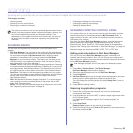
26 | Loading originals and print media
Media sizes supported in each mode
Guidelines for special print media
MODE SIZE SOURCE
Copy mode Letter, A4, Legal,
Oficio, US Folio,
Executive, JIS B5, A5,
A6
tray 1
Print mode All sizes supported by
the printer
tray 1
Fax mode Letter, A4, Legal tray 1
MEDIA TYPE GUIDELINES
Envelopes • Successful printing on envelopes depends upon the
quality of the envelopes. When selecting envelopes,
consider the following factors:
- Weight: The weight of the envelope paper should
not exceed 90 g/m
2
or jamming may occur.
- Construction: Prior to printing, envelopes should
lie flat with less than 6 mm curl, and should not
contain air.
- Condition: Envelopes should not be wrinkled,
nicked, or otherwise damaged.
- Temperature: You should use envelopes that are
compatible with the heat and pressure of the
printer during operation.
• Use only well-constructed envelopes with sharp and
well creased folds.
• Do not use stamped envelopes.
• Do not use envelopes with clasps, snaps, windows,
coated lining, self-adhesive seals, or other synthetic
materials.
• Do not use damaged or poorly made envelopes.
• Ensure that the seam at both ends of the envelope
extends all the way to the corner of the envelope.
1 Acceptable
2 Unacceptable
Envelopes
(Continued)
• Envelopes with a peel-off adhesive strip or with
more than one flap that folds over to seal must use
adhesives compatible with the printer’s fusing
temperature for 0.1 second. Check your printer’s
specification to view the fusing temperature, see
"Printer specifications" on page 73. The extra flaps
and strips might cause wrinkling, creasing, or jams,
and may even damage the fuser.
• For the best print quality, position margins no closer
than 15 mm from the edges of the envelope.
• Avoid printing over the area where the envelope’s
seams meet.
Labels • To avoid damaging the printer, use only labels
designed for use in laser printers.
- When selecting labels, consider the following
factors:
- Adhesives: The adhesive material should be
stable at your printer’s fusing temperature. Check
your printer’s specification to know the fusing
temperature, see "General specifications" on
page 72.
- Arrangement: Only use labels with no exposed
backing between them. Labels can peel off sheets
that have spaces between the labels, causing
serious jams.
- Curl: Prior to printing, labels must lie flat with no
more than 13 mm of curl in any direction.
- Condition: Do not use labels with wrinkles,
bubbles, or other indications of separation.
• Ensure that there is no exposed adhesive material
between labels. Exposed areas can cause labels to
peel off during printing, which can cause paper
jams. Exposed adhesive can also cause damage to
printer components.
• Do not run a sheet of labels through the printer more
than once. The adhesive backing is designed for
only a single pass through the printer.
• Do not use labels that are separating from the
backing sheet or are wrinkled, bubbled, or otherwise
damaged.
Card stock or
custom-sized
materials
• Do not print on media smaller than 76 mm wide or
356 mm long.
• In the software application, set margins at least
6.4 mm away from the edges of the material.
MEDIA TYPE GUIDELINES


















